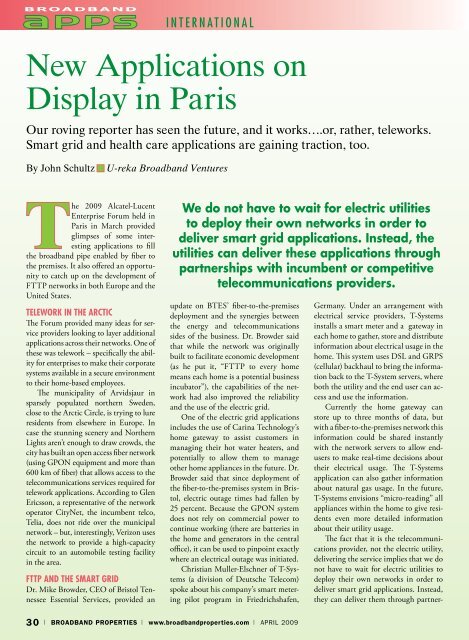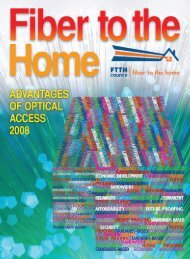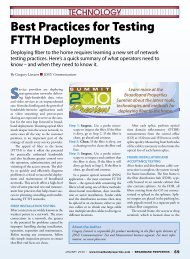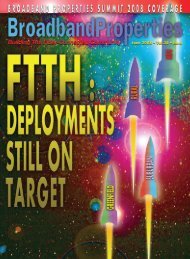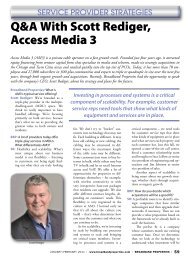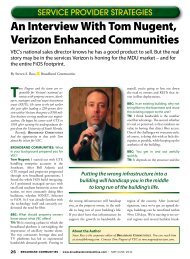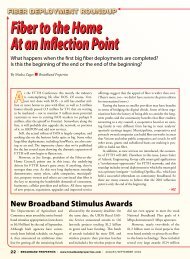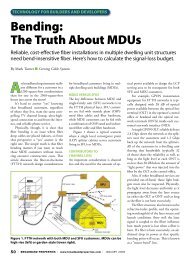Download - Broadband Properties
Download - Broadband Properties
Download - Broadband Properties
Create successful ePaper yourself
Turn your PDF publications into a flip-book with our unique Google optimized e-Paper software.
international<br />
New Applications on<br />
Display in Paris<br />
Our roving reporter has seen the future, and it works….or, rather, teleworks.<br />
Smart grid and health care applications are gaining traction, too.<br />
By John Schultz ■ U-reka <strong>Broadband</strong> Ventures<br />
The 2009 Alcatel-Lucent<br />
Enterprise Forum held in<br />
Paris in March provided<br />
glimpses of some interesting<br />
applications to fill<br />
the broadband pipe enabled by fiber to<br />
the premises. It also offered an opportunity<br />
to catch up on the development of<br />
FTTP networks in both Europe and the<br />
United States.<br />
Telework in the Arctic<br />
The Forum provided many ideas for service<br />
providers looking to layer additional<br />
applications across their networks. One of<br />
these was telework – specifically the ability<br />
for enterprises to make their corporate<br />
systems available in a secure environment<br />
to their home-based employees.<br />
The municipality of Arvidsjaur in<br />
sparsely populated northern Sweden,<br />
close to the Arctic Circle, is trying to lure<br />
residents from elsewhere in Europe. In<br />
case the stunning scenery and Northern<br />
Lights aren’t enough to draw crowds, the<br />
city has built an open access fiber network<br />
(using GPON equipment and more than<br />
600 km of fiber) that allows access to the<br />
telecommunications services required for<br />
telework applications. According to Glen<br />
Ericsson, a representative of the network<br />
operator CityNet, the incumbent telco,<br />
Telia, does not ride over the municipal<br />
network – but, interestingly, Verizon uses<br />
the network to provide a high-capacity<br />
circuit to an automobile testing facility<br />
in the area.<br />
FTTP and the Smart Grid<br />
Dr. Mike Browder, CEO of Bristol Tennessee<br />
Essential Services, provided an<br />
We do not have to wait for electric utilities<br />
to deploy their own networks in order to<br />
deliver smart grid applications. Instead, the<br />
utilities can deliver these applications through<br />
partnerships with incumbent or competitive<br />
telecommunications providers.<br />
update on BTES’ fiber-to-the-premises<br />
deployment and the synergies between<br />
the energy and telecommunications<br />
sides of the business. Dr. Browder said<br />
that while the network was originally<br />
built to facilitate economic development<br />
(as he put it, “FTTP to every home<br />
means each home is a potential business<br />
incubator”), the capabilities of the network<br />
had also improved the reliability<br />
and the use of the electric grid.<br />
One of the electric grid applications<br />
includes the use of Carina Technology’s<br />
home gateway to assist customers in<br />
managing their hot water heaters, and<br />
potentially to allow them to manage<br />
other home appliances in the future. Dr.<br />
Browder said that since deployment of<br />
the fiber-to-the-premises system in Bristol,<br />
electric outage times had fallen by<br />
25 percent. Because the GPON system<br />
does not rely on commercial power to<br />
continue working (there are batteries in<br />
the home and generators in the central<br />
office), it can be used to pinpoint exactly<br />
where an electrical outage was initiated.<br />
Christian Muller-Elschner of T-Systems<br />
(a division of Deutsche Telecom)<br />
spoke about his company’s smart metering<br />
pilot program in Friedrichshafen,<br />
Germany. Under an arrangement with<br />
electrical service providers, T-Systems<br />
installs a smart meter and a gateway in<br />
each home to gather, store and distribute<br />
information about electrical usage in the<br />
home. This system uses DSL and GRPS<br />
(cellular) backhaul to bring the information<br />
back to the T-System servers, where<br />
both the utility and the end user can access<br />
and use the information.<br />
Currently the home gateway can<br />
store up to three months of data, but<br />
with a fiber-to-the-premises network this<br />
information could be shared instantly<br />
with the network servers to allow endusers<br />
to make real-time decisions about<br />
their electrical usage. The T-Systems<br />
application can also gather information<br />
about natural gas usage. In the future,<br />
T-Systems envisions “micro-reading” all<br />
appliances within the home to give residents<br />
even more detailed information<br />
about their utility usage.<br />
The fact that it is the telecommunications<br />
provider, not the electric utility,<br />
delivering the service implies that we do<br />
not have to wait for electric utilities to<br />
deploy their own networks in order to<br />
deliver smart grid applications. Instead,<br />
they can deliver them through partner-<br />
30 | BROADBAND PROPERTIES | www.broadbandproperties.com | April 2009


